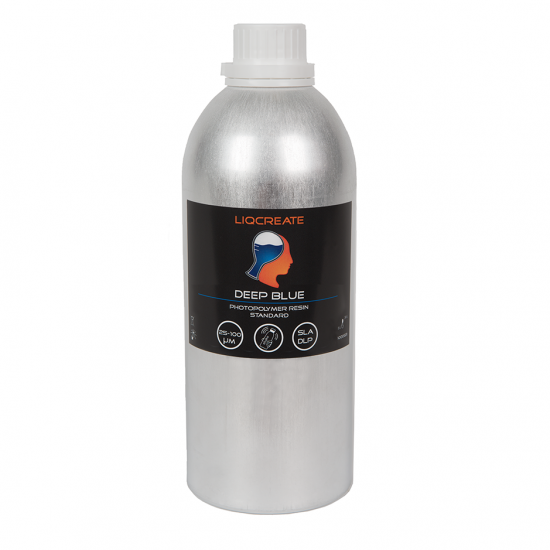Liqcreate Deep Blue is a general purpose photopolymer resin for DLP, SLA and LCD / MSLA technologies in the range of 385 – 405nm. Parts created with Liqcreate Deep Blue have a rigid character and its low shrinkage and high shape retention make this material perfect for the production of functional prototypes.
The aesthetically pleasing blue color, low odor and gasoline & chemical resistant properties makes this this material perfect for rapid manufacturing and prototyping in the industrial and automotive market. In this article you can find tips and tricks to work with Liqcreate Deep Blue 3D-printing resin. If you have any questions, reach out to us at info@liqcreate.com and our technical team will assist.
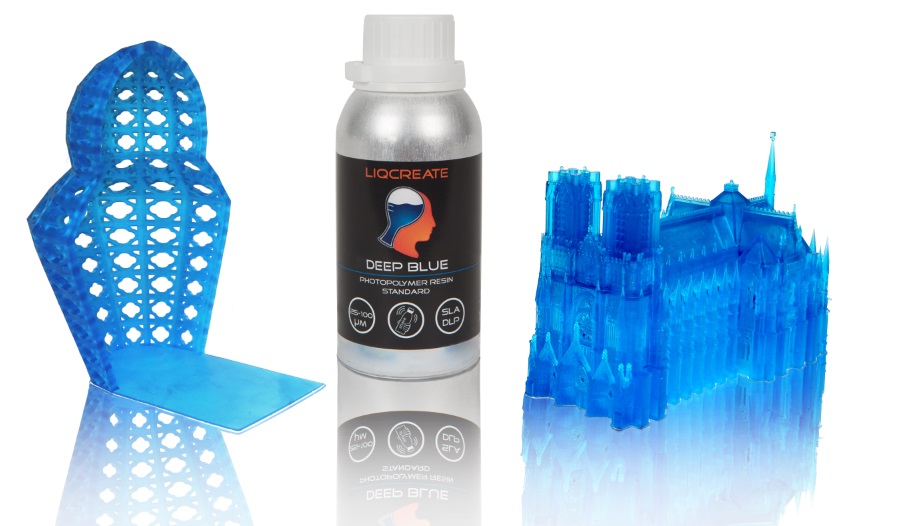
The following topics are covered in this article:
- Shake before use.
- 3D-printing parameters.
- Support settings.
- Cleaning, washing and post-curing your part.
- Discoloration of parts after curing or extended UV aging
- Air bubbles in printed parts
- How to clean/filter the resin?
- Minimum wall thickness.
- Part orientation and over-hang.
- Part surface finish or sticky surface.
- Shrinkage compensation.
- Resin temperature.
- Solving print failures.
- Storage conditions.
- Chemical compatibility & Additional information.
1) Shake before use.
For most resin, shaking for a couple minutes is advised, especially after longer storage to get a homogeneous mixture before printing. Same goes for Liqcreate Deep Blue. Shake for a couple minutes and let the resin rest for a couple minutes before using. During shaking the resin is homogenized, but some air bubbles will be present. If you start a print job right after shaking, air bubbles might be present in the first layers of the part.
2) 3D-printing parameters.
Liqcreate Deep Blue 3D-printing resin is designed for open compatibility on 405nm and 385nm DLP, MSLA, LCD and laser-based resin 3D-printers. It is important that the 3D-printer is open for 3rd party resins and parameters can be changed. A lot of parameters are already prepared and listed here. Click on your actual printer to see if Liqcreate Deep Blue parameters are available. If that is not the case, send an e-mail to our technical team at info@liqcreate.com and they will try to help.
3) Support settings.
Support settings are depending on the type of resin in combination with the type of printer, release mechanism, material on the bottom of the resin tank and also the secondary settings like print speed. With the extreme growth of available resin 3D-printers in the past years, it is impossible to give validated support settings for each printer. In this section you can find settings for some generic printers, design and print speed. We tested a standard design with different settings. If your part is more bulky / large cross-section for each layer, then the support tip thickness or intersection might need to be increased.
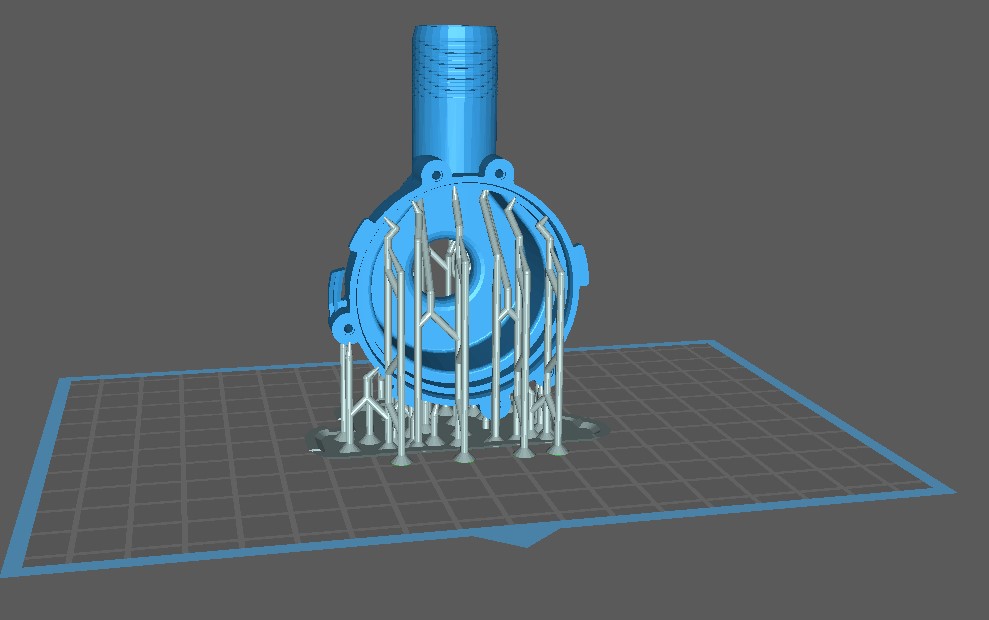
Image: Test parts to optimize support settings.
Support settings on the Anycubic Photon M3 were successfully validated for this part and can be found below. In chapter 7 we explain how to orient and to minimize large bottom surfaces. We tested a standard design with different settings. If your part is more bulky / large cross-section for each layer, then the support tip thickness or intersection might need to be increased.

Image: support settings of Deep Blue with our generic test parts, tested on the Anycubic Photon M3 resin 3D-printer.
4) Cleaning, washing and post-curing your part.
Washing is similar to other Liqcreate resins. wash in either IPA, Ethanol or Liqcreate resin cleaner. For resin cleaner the cleaning instructions on that webpage can be used. For IPA and Ethanol they can be used in an ultrasonic cleaner or cleaner with agitation (like the new low costs Anycubic / Elegoo washing unit). Preferably 2 times for 3 minutes washing and the second time in fresh IPA / ethanol. If there are small cavities that are not cleaned by this method, then use a soft brush to clean them out and wash in fresh solvent again for 1 minute. Then let the part dry.
Before post-curing, inspect that the part is dry and completely free from solvent (no shiny resin spots on the surface). Otherwise wash again in fresh solvent for 1 minute. Do not wash for longer than necessary as parts can deform when exposed to IPA / Ethanol for >20 minutes when not fully cured. Also be careful if your parts are thin (<2mm) and the IPA in the ultrasonic cleaner is warm (>30°C), parts can warp. If you notice this, either make the parts thicker or wait until the temperature of the IPA is below 30°C.
When small holes and tight corners are difficult to clean, then brushing with a soft brush is advised to clean these specific areas. After brushing, rinse in fresh IPA / ethanol to get all resin leftovers cleaned.
UV post-curing is important to achieve optimal properties and chemical resistance with Deep Blue. UV post-curing in a heated curing unit, cure for 30 minutes at 60°C is advised. For applications that do not require its maximum chemical compatibility or properties, 30 minutes curing in an entry level curing unit can be sufficient. Extended post-curing information and settings for different curing units can be found in this link.
5) Discoloration of parts after curing or extended UV-aging
When parts printed with Deep Blue are exposed to UV and temperature, they can slightly discolor. Images below show what kind of color can be expected. This is mostly visible in thinner areas as indicated by the red arrow in the image below.
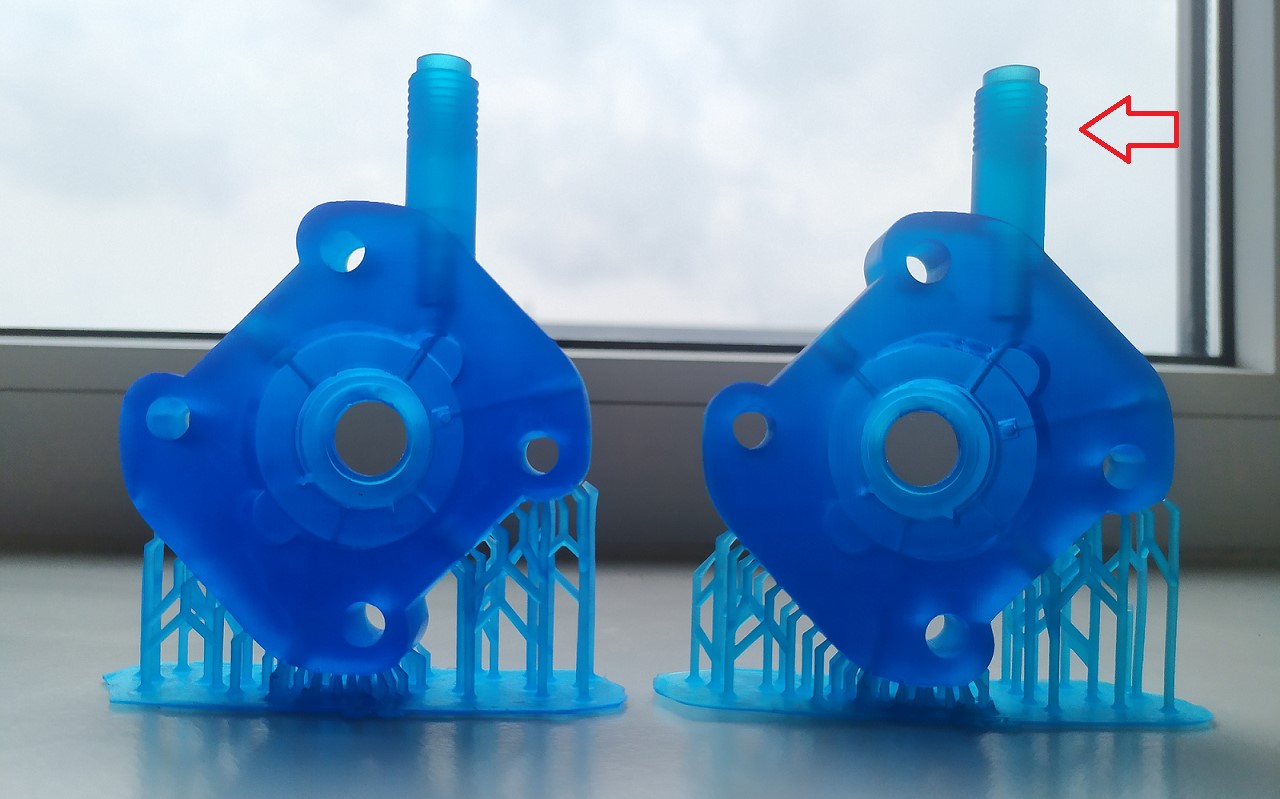
Image: Printed Deep Blue parts, fresh (left) and after 30 minutes UV-curing at 60°C (right).
6) Air bubbles in printed part
It can occur that there are trapped air bubbles inside a printed part. This can happen even after waiting till all air bubbles from shaking are released from the resin. Although there are some theories why this happens, it is difficult to proof the specific reason. In transparent resins this is mostly visible and usually happens in thicker areas of the part. What helps is to reduce the layer thickness to reduce trapped air bubbles in printed parts. During testing we noticed that there were far more bubbles present in the same part printed at 0,1mm layer thickness compared to 0,05mm.
7) How to clean / filter the resin?
When a part failed during printing, it is always advised to clean your resin tank. This is usually done by filtering the resin to make sure all rigid plastic pieces are gone. If cured resin parts are present when you start a new print, they can damage your FEP film of even your LCD screen. A standard resin filter will work sufficiently to filter Deep Blue resin.
8) Minimum wall thickness.
The advised average minimal wall thickness for Liqcreate Deep Blue is 2mm. it is possible to print finer details in local areas. Also larger thin walls can be printed but will require extra support structures for successful printing.
9) Part orientation and over-hang.
It is not advised to print large and relatively flat parts on supports. if possible, always print at an angle to prevent large bottom surfaces as the quality when printing in an angle is much better. In this test we printed a part from Thingiverse and also made a modification on it to see at which angle the parts can be printed. The thingiverse file was rather solid, while our own modification had a wall thickness of 2.0 mm.
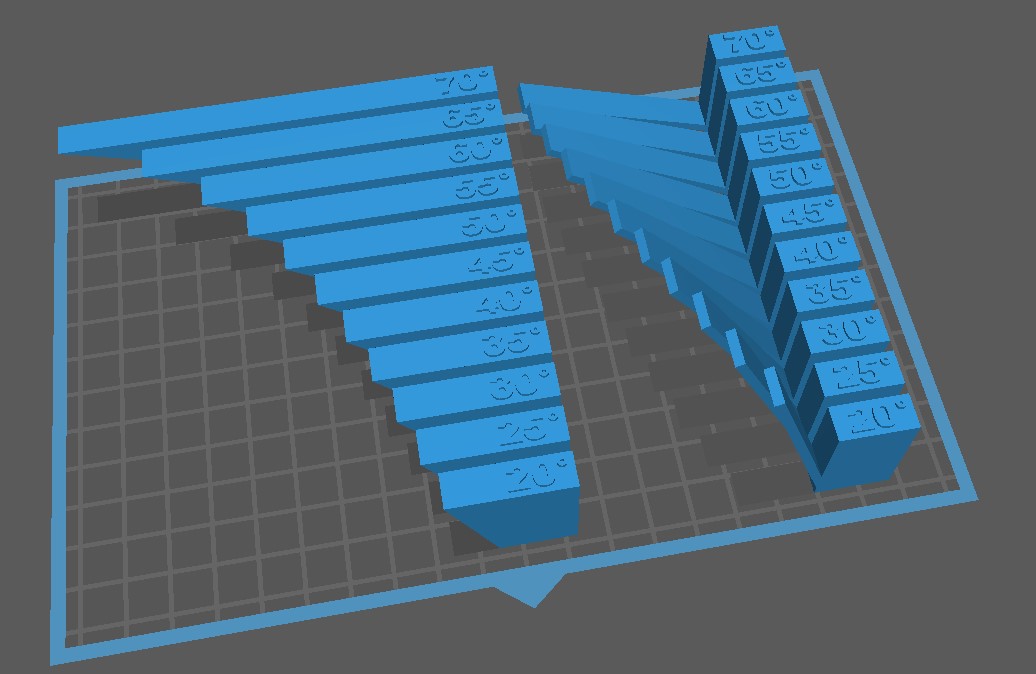
Image: Testing printing angle with the Thingiverse (Thing 40382) file and a small modification of it with thinner walls (2.0 mm).
As expected with a rigid resin, all parts printed well, even with an angle of 70°. But what you see is that the 2mm thick part starts to deform slightly at an angle above 45° and the dense part at an angle above 55°. It is advised to support parts from 40°.
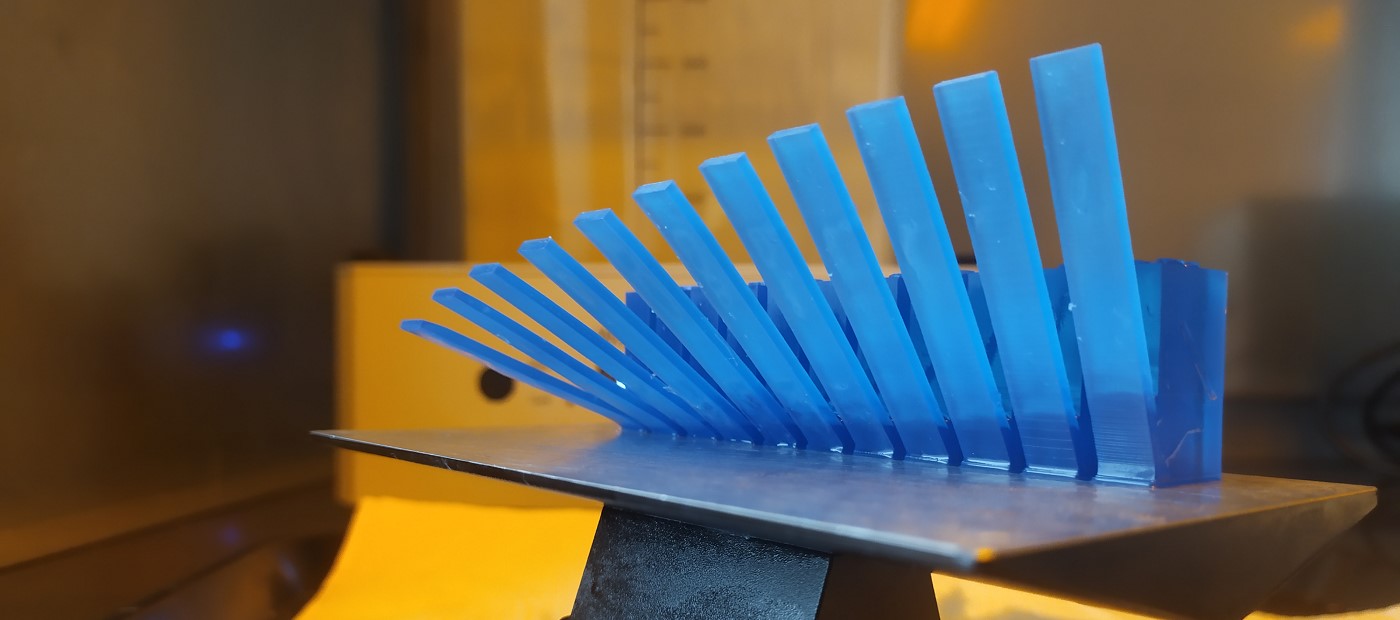
Image: test to print at different angle without supports with Liqcreate Deep Blue resin.
10) Part surface finish or sticky surface.
Printed parts from Liqcreate Deep Blue are translucent blue during printing. A matte / dull surface will appear after washing and drying as in the picture below. Parts can be polished or coated to get a glossy surface finish.
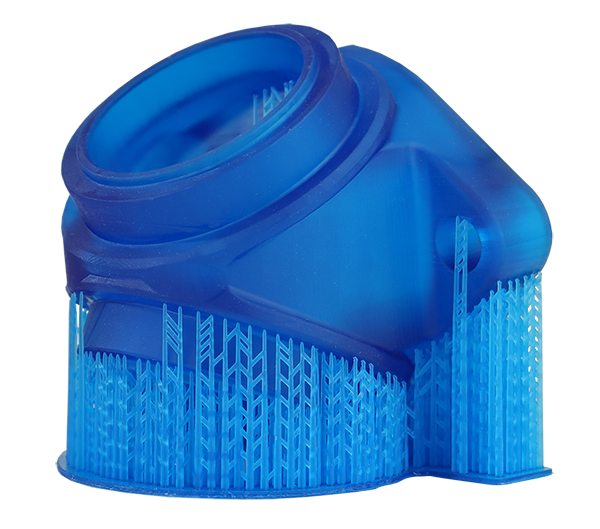
11) Shrinkage compensation.
Tested on the Elegoo Saturn 3, the shrinkage compensation in Chitubox to get better accuracy can be found in the picture below. If you need super accurate parts, it is worth to read this article and find already tested pre-settings in this article.
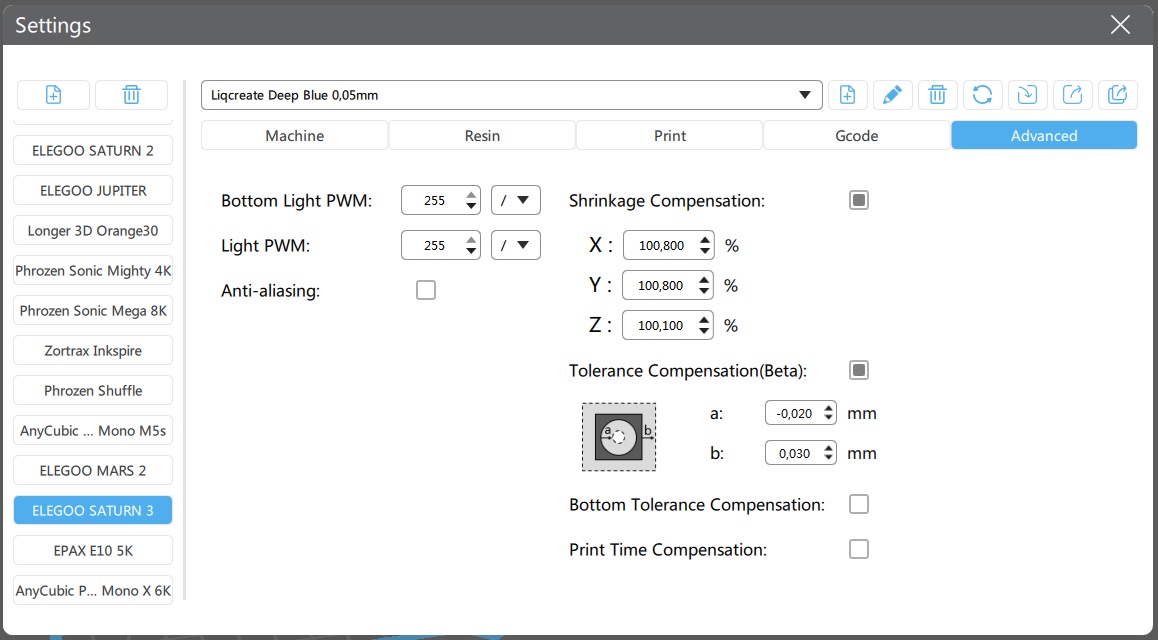
Image: Shrinkage / tolerance compensation for Deep Blue in Chitubox tested on the Elegoo Saturn 3.
12) Resin temperature.
It is advised to print with Liqcreate Deep Blue resin at at 20°C / 68°F and maximum at 25°C / 77°F. printing at lower temperature causes random failure in the material. Excessive heating can lead to faster de-mixing of the resin and is not advised.
13) Solving print failures with Liqcreate Deep Blue resin.
There are a lot of common resin 3D-printing issues. In this article you can find 10 common resin 3D-printing fails and how to solve them. If you have need support, send is an e-mail at info@liqcreate.com and our technical team will try to assist.
14) Storage conditions.
Store the product in its original bottle, plug and cap at minimal 5°C / 41°F and maximum 30°C / 86°F. Avoid sources of heat, radiation, static electricity, sunlight and contact with food.
15) Chemical compatibility & Additional information.
Liqcreate Deep Blue is an unique 3D-printing photopolymer resin with very good chemical compatibility against most solvents and liquids. Learn more about the chemical compatibility and thermal aging in the following articles:
- – Liqcreate Deep Blue product page
- – Chemical compatibility of Liqcreate Deep Blue
- – Thermal aging of Liqcreate Deep Blue
- – Technical Datasheet Liqcreate Deep Blue
- – 3D-printing parameters of Liqcreate Deep Blue
If you have any questions when working with Liqcreate Deep Blue resin, send us an e-mail at info@liqcreate.com.
Support
Do you need any help with 3D printing our SLA, DLP or LCD resins? We can help you! Just look for the question you have below. If you can’t find it, let us know by contacting us!
Printer Settings →
Deep Blue
Liqcreate Deep Blue is a general purpose photopolymer for DLP and SLA technologies in the range of 385 – 405nm. Parts created with Liqcreate Deep Blue have a rigid character and its low shrinkage and high shape retention make this material perfect for the production of functional prototypes. The aesthetically pleasing blue color, low odor and overall properties make the material perfect for rapid manufacturing and prototyping in the prosumer market.
Key benefits |
3D-Printer compatibility |
| · Smooth surface finish | · Atum3D DLP Station 5 |
| · High accuracy | · Formlabs Form2 |
| · Low odor | · Elegoo series |
| · Low shrinkage | · Anycubic series |
| · High translucency | · And many more |
